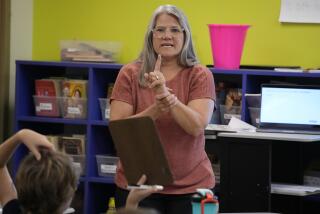For Fry’s, It’s a Prime Time to Support Higher Math
- Share via
Shopping at Fry’s Electronics Inc. stores has always struck me as a form of geek penance: Its indifferent customer service, onerous returns system and not-always-so-low prices are legendary among the clientele drawn in by the chain’s vast inventory.
This is, admittedly, a churlish way to lead up to an aspect of Fry’s that merits our unalloyed admiration: Under its publicity-shy founder, John Fry, the San Jose company has endowed one of the most remarkable academic institutes in the country.
The American Institute of Mathematics lies behind a heavy steel door situated just next to the main entrance of Fry’s Palo Alto store. A bright mural hangs on the outside wall as a signpost, explains AIM Executive Director Brian Conrey, because visitors used to have trouble finding the nondescript doorway even with explicit directions.
AIM currently receives about $1 million a year from the closely held company and a Fry family foundation, and another $1 million from the National Science Foundation. Since its 1994 founding, the institute has been devoted to cracking the most elusive problems in higher math by organizing workshops that bring together leading experts for top-level brainstorming.
To appreciate the uniqueness of such collaboration one must understand the traditionally hermetic work habits of mathematicians.
“If you look at the literature you will find that maybe 70 years ago, almost every paper was single-authored,” says Peter Sarnak, a Princeton University mathematician. “AIM was the first to bring together teams with major success.”
For example, AIM can claim a hand in the 2002 proof of the “perfect graph conjecture,” an important problem in communications networking, by members of a group that the institute had funded.
But mathematics being what it is, a large part of AIM’s work has been a quest for the Holy Grail of number theory: a proof of the Riemann Hypothesis.
In this space I couldn’t explain the Riemann Hypothesis without simplifying it to the point of caricature. Suffice to say that it’s an 1859 guess by the mathematician Bernhard Riemann that certain solutions to a mathematical operation known as the zeta function -- its “zeros,” or inputs that make the function equal 0 -- can be graphed with startling symmetry along a certain straight line.
The hypothesis fascinates mathematicians in part because the zeta function is closely related to the distribution of prime numbers (numbers divisible only by themselves and 1). Primes are important in number theory because every integer is either a prime or the product of primes.
The search for a proof has been driven by discoveries that zeta functions lie behind a wide range of mathematical relationships.
“It’s the tip of a much bigger thing we’re struggling with,” Conrey told me, “and the last elementary function we don’t understand.” It doesn’t hurt that a $1-million prize -- one of seven that a Boston businessman, Landon Clay, established in 2000 for the solutions to seven top mathematical challenges -- awaits the victor in the race.
So far, experts have verified the Riemann Hypothesis for points on the number line out to the tens of billions, but that’s not the same as proving its fundamental truth. Conrey himself holds the world record for the largest percentage of zeros proved to lie on Riemann’s line -- a mere 40%, a mark he set in 1987.
Now and then a mathematician will suggest that the hypothesis has resisted proof for so long because it’s inherently unprovable or even false, but that’s a distinctly minority view.
The hypothesis, as it happens, was instrumental in bringing Conrey to AIM. Conrey, now 49, had done his undergraduate work at Santa Clara University, where John Fry was a fellow mathematics student. Gerald Alexanderson, who later became AIM’s board chairman, had headed the math department.
At a convocation in 1996, Conrey told the AIM advisory board that the hypothesis would be an ideal target for the collaborative approach the institute was promoting. The result later that year was the first AIM workshop, which brought together 70 physicists, computer scientists, number theorists and analytical mathematicians -- representing all the varied disciplines then taking stabs at the hypothesis, mostly in snug isolation.
The stage was set for a new paradigm in math research.
“People said there was no way you could make it work,” Conrey recalls, “but that whole week it felt like something different was happening.” He became AIM’s executive director the next year.
AIM is working toward a schedule of 24 workshops a year, each with a maximum of 32 participants, devoted to a wide range of issues. That will be a lot easier once the institute moves into a spacious permanent home it plans to build in Morgan Hill, south of San Jose, as a temple to the pursuit of pure knowledge.
For that’s the aspect of the field that sets mathematicians apart. Although prime numbers recently acquired commercial value as keys to secure encryption systems -- and notwithstanding Clay’s $1-million prize -- most seem to be searching for an orderliness belying nature’s apparent dishevelment.
Riemann’s Hypothesis is central to AIM because it symbolizes that absolute tidiness.
“The primes on the one hand seem very unruly and unpredictable,” Conrey says. “On the other hand, having these zeros all on the line is just spectacular.”
When I asked whether he harbored any doubts about the truth of the hypothesis, he answered with a sort of mathematician’s credo.
“That would be a really mean trick, somehow,” he says. “It’s too beautiful not to be true.”
*
Golden State appears every Monday and Thursday. You can reach Michael Hiltzik at golden.state@latimes.com and read his previous columns at latimes.com/hiltzik.
More to Read
Inside the business of entertainment
The Wide Shot brings you news, analysis and insights on everything from streaming wars to production — and what it all means for the future.
You may occasionally receive promotional content from the Los Angeles Times.











